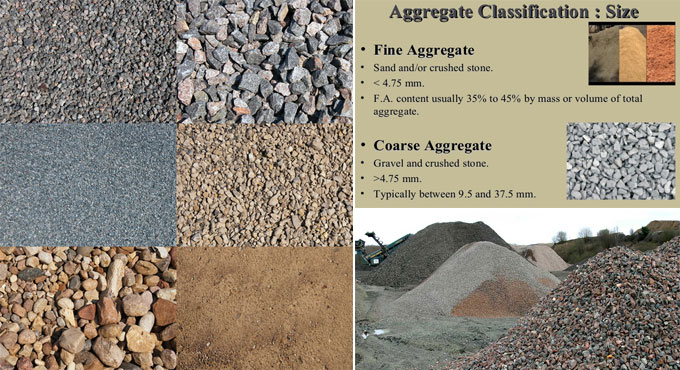
Introduction about fine aggregate and course aggregate

Aggregates are frequently applied as the raw material in concrete mixtures. Sand, gravel or crushed stone are considered as the most vital materials in the concrete mix and cover roughly 60% to 75% of the total volume of the concrete. The main objective of aggregate is to unite the concrete.
There are two types of aggregates like fine and coarse aggregates. Both can be applied to develop concrete and available in the foundation of a road or even on the roof of a building. Give below, the basic differences among fine aggregates and coarse aggregates.
Fine aggregate Vs Coarse Aggregate: Both stand for filler materials in concrete mixtures but the material created with a mixture of smaller particles of grains and minerals is known as fine aggregate, and the material along with gravels, cobble, and boulders is called as the coarse aggregate.
In coarse aggregates, the sizes of the particles remain in excess of 4.75mm; Although, the size may vary between 9.5mm to 37.5mm in diameter for greater size aggregates. At the same time, fine aggregates can go through 9 mm sieve due to their small size.
Variations among Fine and Coarse Aggregate based on the size:
With adherence to the IS specifications, the fine aggregates are categorized into coarse sand, medium sand, and fine sand. Alternatively, there are several categories of coarse aggregates like primary, secondary and recycled.
? Fine aggregates comprise of natural sand and stone which are graded into Zone 1 to Zone 4 depending on its ability to move through the 600-micron. The zones become gradually finer from Zone-1 to Zone-4. As per zones, 90% to 100% of the fine aggregate moves through 4.75 mm IS sieve and 0 to 15% moves through 150 microns IS sieve.
? The minimal size of coarse aggregate is 40 mm, 20 mm, 16 mm and 12.5 mm.
Variation among Fine and Coarse Aggregate based on source
? According to the source, the coarse aggregate is classified into the following three categories:
a. Uncrushed Gravel or Stone that is developed by decomposing the rocks in normal way.
b. Crushed Gravel or Stone that is developed by crushing of gravel or hard stone.
c. Partly crushed gravel or stone, that is produced with admixture of the above two aggregate.
? According to the source, there are three different categories of fine aggregates, such as:
a. Natural Sand produced by decomposing the rock. The method of decomposition and deposition by streams or glacial agencies is fully normal.
b. Crushed Stone Sand developed by crushing the hard stones.
c. Crushed Gravel Sand, developed by crushing the natural gravel.
Fine aggregates are provided for building up thin-wall and traditional reinforced concrete structural elements. Because of its fine grained structure, it is mostly found in highway and airfield construction. The application of fine aggregate raises the necessary quantity of binder, that is decreased with coarse aggregates. Therefore, a perfect ratio of both fine and coarse aggregate is required to enhance the strength and stability of any concrete structure.


